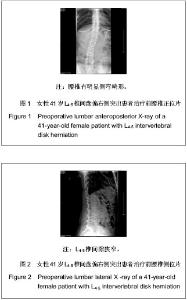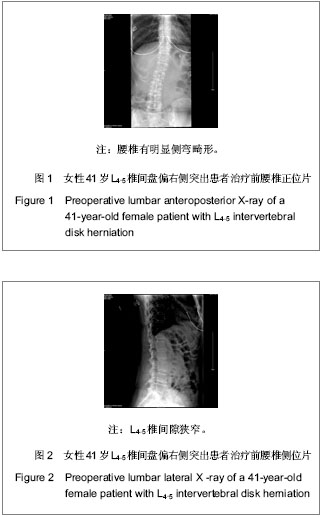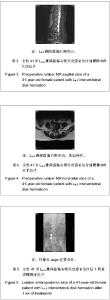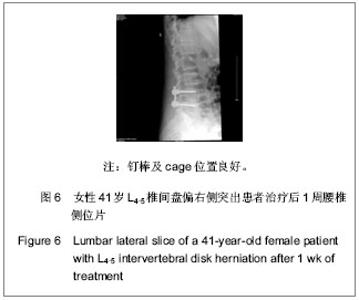| [1] Inoue S,Kataoka H,Tajima N,et al. Assessment of treatment for low back pain.J Jpn Orthop Ass. 1986;60:391-394.
[2] Suk S,Lee CK,Kim WJ,et al.Adding posterior lumbar interbody fusion to pedicle screw fixation and posterolateral fusion after decompression in spondylolytic spondylolishthesis. Spine.1997;22(2):210-219.
[3] 邱贵兴,王正义,王满宜,等.骨科学高级教程[M].北京:人民军医出版社, 2010:418-419.
[4] 胥少汀.关于腰椎疾患行融合与内固定的意见[J].中国脊柱脊髓杂志,2005,15(7):394-396.
[5] 杨文成,董有海.腰椎椎间融合研究进展[J].国际骨科学杂志, 2011, 32(1):37.
[6] 王建华,万磊,夏虹,等.单枚融合器与单钉棒系统微创术式的有限元研究[J].临床骨科杂志,2010,13(6):700-703.
[7] 郑琦,廖胜辉,魏威,等.复杂性腰椎管狭窄症减压和椎间融合的有限元分析[J].中国生物医学工程学报,2012,31(4):566.
[8] Chang TS,Chang JH,Wang CS,et al.Evaluation of unilateral cage-instrumented fixation for lumbar spine. J Orthop Surg Res.2010;5:86.
[9] Vadapalli S,Robon M,Biyani A,et al.Effect of lumbar interbody cage genmetry on construct stability:a cadaveric study. Spine (Phila Pa 1976).2006;31(19):2189-2194.
[10] Niemeyer TK,Koriller M,Claes L,et al.In vitro study of biomechanical behavior of anterior and transforaminal lumbar interbody instrumentation techniques. Neurosurgery. 2006; 59(6):1271-1276.
[11] Sudo H,Oda I,Abumi K,et al.Biomechanical study on the effect of five different lumbar reconstruction techniques on adjacent-level intradiscal pressure and lamina strain.J Neurosurg Spine.2006;5(2):150-155.
[12] Villavicencio AT,Burneikiene S,Bulsara KR,et al. Perioperative complications in transforaminal lumbar interbody fusion versus anterior-posterior reconstruction for lumbar disc degeneration and instability. J Spine Disord Tech.2006; 19(2):92-97.
[13] Yu CH,Wang CT,Chen PQ. Instrumented posterior lumbar interbody fusion in adult spondylolisthesis.Clin Orthop Relat Res.2008;466(12):3034-3043.
[14] Denozière G, Ku DN.Biomechanical comparison between fusion of two vertebrae and implantation of an artificial intervertebral disc. J Biomech.2006;39(4):766-775.
[15] 苗惊雷,张朝跃,詹瑞森,等.置入椎间融合器行腰椎融合后cage移位的原因[J].中国组织工程研究与临床康复,2011,15(39): 7307-7310.
[16] 陈家麟,茅祖斌,吴小涛,等. 四种经椎间孔腰椎间融合固定方式的三维有限元分析[J].中国组织工程研究与临床康复,2008, 12(39):7605-7610.
[17] 王炤,赵杰,王以近,等. 单枚腰椎间融合器附加椎弓根螺钉行后路腰椎椎体间融合术的生物力学评价[J]. 第二军医大学学报, 2004,25(4):422-425.
[18] 陈志明,马华松,赵杰,等.腰椎单侧椎弓根螺钉固定的三维有限元分析[J].中国脊柱脊髓杂志,2010,20(8):684-688.
[19] 张振辉,陶志强,伍绍成,等.椎弓根螺钉及融合器应力分布在腰椎滑脱后路骨融合模型的三维有限元分析[J].中国组织工程研究与临床康复,2010,14(48):8958-8961.
[20] 李东哲,陈飞,康意军,等. 以三维有限元分析两种方法L4/5椎间融合后的螺钉应力[J].中国组织工程研究与临床康复,2011, 15(13):2295-2298.
[21] 董继武,石国华,胡跃,等.短节段椎弓根螺钉加椎间融合器治疗腰椎滑脱症[J].西南军医,2011,13(2):247-248.
[22] 刘汉平,葛崇林,马超,等.钉棒系统内固定联合cage融合器治疗腰椎滑脱症[J].当代医学,2012,18(36):66-67.
[23] 梁博伟,赵劲民,李宁宁,等.微创经椎间孔椎体间融合联合单侧椎弓根螺钉固定术治疗椎间盘源性腰痛[J].中国修复重建外科杂志,2012,26(3):272-276.
[24] 陈钢,黄宏伟,陈永雄,等.单枚椎间融合器结合椎弓根钉棒系统治疗腰椎滑脱症[J].中国骨与关节损伤杂志,2012,27(7):621-622.
[25] 陈世忠.椎间融合器与单纯椎间植骨法治疗退变性腰椎滑脱症的疗效分析[J].中国骨与关节损伤杂志,2010,25(5):439-440.
[26] 李建明,杨列东,卢伟,等.RF系统和单枚BAK椎间融合器治疗腰椎滑脱[J].中国实用医药,2010,5(4):122.
[27] 周忠民,李牧,谢斌,等.改良椎间植骨融合联合椎弓根钉内固定治疗峡部裂性腰椎滑脱症[J].中国骨与关节损伤杂志,2010, 25(5): 446-447.
[28] 孟纯阳,唐可,欧云生,等.椎弓根螺钉系统加后路椎间融合术治疗腰椎滑脱症疗效分析[J].中国修复重建外科杂志,2010,24(8): 904-907.
[29] 陈灼,李振宇.三种融合材料在TLIF手术治疗腰椎滑脱中融合作用的研究[J].中国骨与关节损伤杂志,2010,25(5):437-438.
[30] 秦彦超,马迅.两种椎间融合方法治疗腰椎滑脱症的疗效比较[J].山西医科大学学报,2010,41(5):458-461.
[31] 徐杰,刘春华,黄惠梅,等.后路单枚Cage植骨融合联合椎弓根钉棒系统治疗腰椎滑脱症[J].中国修复重建外科杂志,2012, 26(7): 891-892.
[32] 李翊.椎板减压椎间植骨融合器椎弓根钉棒系统固定融合术治疗老年人退行性腰椎滑脱的疗效分析[J]。实用临床医药杂志, 2013,17(7):69-72.
[33] 孙刚,曲成明,孙歆.椎体间融合器加钉棒系统治疗退行性腰椎不稳症[J].齐鲁医学杂志,2008,23(5):429-431.
[34] 胡明,马远征,才小军,等.膨胀式融合器(B-twin)联合椎弓根钉棒系统治疗腰椎退变性疾病的临床研究[J].中国骨与关节损伤杂志,2010,25(5):394-396.
[35] 邹凯,车彪,王凯,等.单枚椎间融合器联合椎弓根螺钉治疗峡部裂型腰椎滑脱的效果观察[J].中国医药导报,2013,10(18):69-71.
[36] 郭利辉,姚猛,周昌伟,等.椎弓根螺钉联合单枚椎间融合器治疗腰椎疾病临床研究[J]哈尔滨医科大学学报,2013,47(2):171-174.
[37] 陈志明,马华松,王晓平,等.腰椎单侧或双侧椎弓根螺钉固定结合单枚融合器植入的临床对比研究[J].中国骨与关节外科,2013, 6(2):126-130. |





